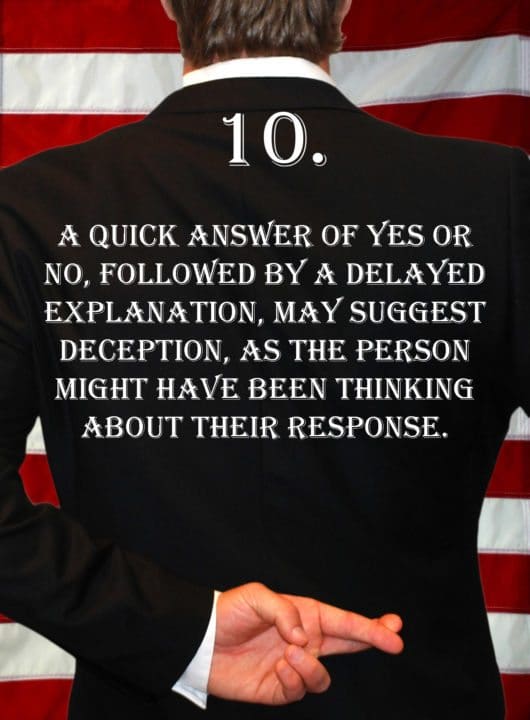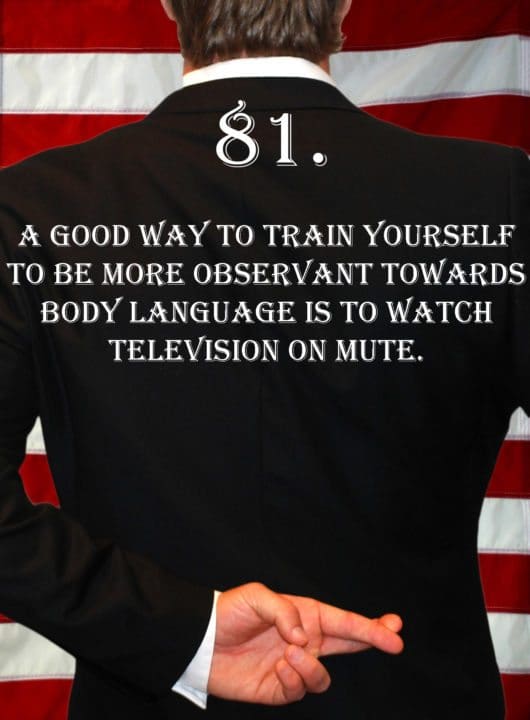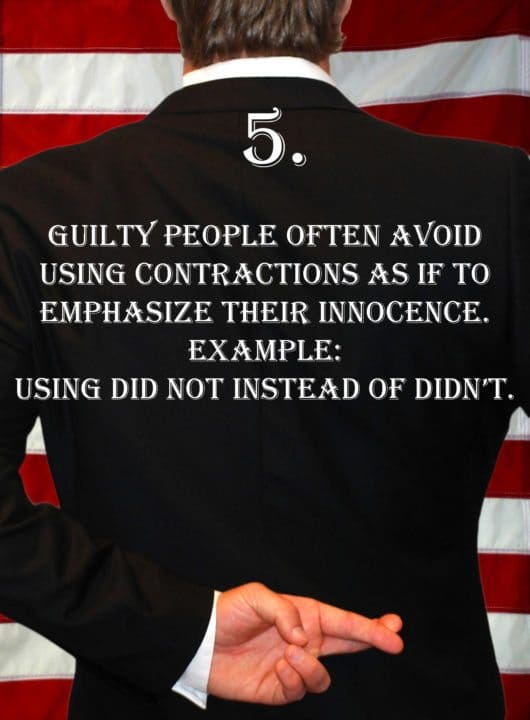
Deception Tip 10:
A quick answer of yes or no, followed by a delayed explanation, may suggest deception, as the person might have been thinking about their response.
Listen To The Podcast!
E10 – Quick Answers – Deception Tips Podcast – Click Here To Subscribe
Podcast Transcript
Hello, and welcome to the Deception Tips Podcast, where you will learn amazing cues to detect deceit that will help you read people like never before. I’m your host, Spencer Coffman. Let’s get started.
Welcome to episode 10 of the Deception Tips Podcast. Last time, we talked about something that had the potential to be quite confusing, but once you learn about it, listen to it, and start to understand it, it’s really quite simple. We talked about people taking negative statements and making them positive, or positive statements and making them negative.
They do this in two different ways. Number one would be making a statement, such as “I did it,” and adding a “not” in there. So, “I did not do it.” Something like that. You took a positive statement and made it negative.
In addition, you could add a “yes” or “no” before that, thus negating that statement, making it a contradictory statement. And then also adding in the “not,” or taking out a “not,” and making it a positive or a negative statement.
For example, “Did you do this?” “No. I did not do that.” You’re adding two negatives to that positive statement, making the whole thing negative. Or you could say, “Yes. I did not do that.” Now it becomes contradictory because you said: “yes,” now you’re saying you didn’t do it and you added the “not” in there.
Typically, you would have said, “Yes, I did it.” There it’s both positive, both together, working efficiently, and they are not contradicting each other. That would be a truthful statement. It’s kind of a confusing scenario.
I encourage you to go back. Listen to episode 9 once more and work that through your head. Specifically listen to the parts where the different examples are explained because, as we said, there can be two types of questions.
The first one would be, obviously, a yes-or-no question and the typical response to those would be a ‘yes’ or ‘no’ answer. However, when a yes-or-no answer is given in addition to a positive or negative statement converted, such as “Yes. I did not do it.” Now you’ve converted that “did do it” statement, which was positive, into a negative.
That is converting that statement. That is a sign of deception. The typical, obvious answer would be a “yes” or “no” answer, so you don’t need to add that extra stuff on there. Anytime someone adds that extra stuff on there, potentially a sign of deception.
The other question is a question that should never be in existence. And the people that ask them are- if they are doing them for a specific purpose then they have that intention through an interrogation method- otherwise, anyone else who asks them, they aren’t thinking properly when they ask these questions because it is a projecting type of question that assumes that someone is already guilty, or has already done something before they are even given a chance to respond.
Therefore, those responses are typically done in defense, or under a defensive mentality, because that person feels like they are being attacked.
An example of that was, “You took my money, didn’t you?” That is such an attacking question. I am automatically assuming you took my money. Instead, I should say, “Did you take my money?”
Now, you can easily reply with “yes” or “no.” But if I say, “You didn’t take my money, did you? Oh, well I’m not assuming you took my money.” YES! I’m directly implying it. That is the nature of that question.
It is sort of a passive-aggressive thing where I say, “You didn’t take my money did you?” I didn’t just accuse you directly of taking my money, but I passively accused you of taking my money.
So, therefore your response will be both consciously, and unconsciously, done in defense. Plus, you will add in those “yes,” “no’s” “I did do it,” and “I didn’t do it,” types of responses that will further complicate the matter.
So, number one, it’s defense. Number two, you’re adding “yes” and “no” responses to a non-yes-or-no question that, really if I say “You didn’t take my money, did you?” and you say “Yes,” or “No,” both of those answers can both be interpreted as a confirmation, or a negation, of that question.
Therefore, those questions are very confusing and should never be asked, but if they are asked and someone responds, you have a lot of things to consider in your mind.
Consider whether they are answering defensively. There are “yes’s” and “no’s.” What are they negating? Are they negating the statements themselves or are they negating the question? There’s a lot to interpret.
So, in those types of scenarios always look for other signs of deception in body language signs. Look for the nonverbal leakage. Those will be your ally in that scenario.
Today, we are going to talk about another verbal sign of deception. This one I hinted on last week when I said “quick answers of ‘yes’ or ‘no.’” Such as when people say “yes” and then they go into their explanation. Or they say “no” and then they go into their explanation. Obviously, in a yes-or-no question, the simplest and most effective answer is always “yes” or “no.” By definition, that is why they are called yes-or-no questions.
However, many times, you get people answering “yes” or “no” and then they go on with some lengthy explanation because they think you care when really, all you wanted to know was “yes” or “no.”
When people answer questions, all they need to do is say “yes” or “no.” Nothing else is needed. If an explanation is needed, the questioner will ask. A quick answer of “yes” or “no” followed by a delayed explanation would be a sign of deception.
So, here it is. Deception Tip number 10: A quick answer of “yes” or “no” followed by a delayed explanation, may suggest deception as the person might have been thinking about their response. Here it is again. A quick answer of “yes” or “no” followed by a delayed explanation, may suggest deception as the person might have been thinking about their response.
The reason these answers or these explanations are delayed is to give the person time to run that lie through their head one last time before they say it out loud. The reason, again this is considered deception, is because, with a yes-or-no question, the answer should be “yes” or “no.”
Typically, this is done because when people answer “yes” or “no,”- Boom- that’s a truthful statement. However, this form of leakage comes about with a delayed explanation.
Normally when you ask someone a question and its yes-or-no, they say “yes” and start explaining right away or they say “no” and start explaining right away. Or, they just say “yes” or “no” and leave it at that. Preferably, that’s what they do.
However, on occasion, someone may say “yes” and their “yes” may not be an immediate “yes,” although, in this instance, it’s usually an immediate “yes” or “no” because they are dying to get that lie out. And then they realize, “Wait a minute! I said yes too quickly. I need to explain that lie.”
Because, oftentimes, when people lie, they are not only trying to convince the target of the lie, they are also working very hard to convince themselves because the conscious has to convince the unconscious that what they are saying is true.
Oftentimes, the liar goes through more stress and more anxiety in convincing themselves about the lie than about convincing the target. Targets are very easy to convince. The majority of people out there have NO clue about any of these signs of deception. Lying to them is super easy.
Yet, when someone lies, because internally they know something off about it, there is more stress and anxiety about convincing themselves that that lie is going to work than convincing the target. We’re going to talk about this sign of deception, and this verbal response rate, when we come back.
How would you like to really know what every body is saying? Understanding body language can help you in your career, your relationships, and in everyday interactions. Get Spencer Coffman’s A Guide to Deception online today.
Liars may often respond with quick “yes’s” or “no’s” and delayed explanations when they lie. Now, examples of this could be a couple of different ways. The quick “yes’s” and “no’s” followed by an explanation is one. On other occasions, they may stretch out the “yes” or “no,” so that may be a quick response, but the answer itself may take longer than a normal “yes.”
For example, if you ask me a question and it’s yes-or-no, and I know the answer in my head, it takes less than a second like half a second for me to reply and say “yes.” It doesn’t take long to get the word “yes” out of the mouth, or the word “no” out of the mouth.
When people delay those or stretch them out, you could ask them the question, and immediately, within a fraction of a second, I could answer, or at least start to answer. I could say- right when you’re done with your sentence before you even take a breath- “yeees,” which would be a delayed “yes,” or “nooo,” which would be a delayed “no.”
But even though I started the response immediately, I stretched out those words and that signals to the questioner that there is an explanation coming. Or, in the movies or everywhere, there’s always a “but.” That’s what they say. “Yeesss.” Then the questioner’s like “But what?” Or “Nooooo.” “But what?” Because you know that there is an explanation coming after that. That kind of response signals that there is more on the way.
So, when someone stretches them out and delays that out in preparation for that explanation, that typically is a more truthful response than not. Because it’s tough to both consciously and unconsciously plan that type of response out.
However, there are liars out there that will know this and they will purposefully, and specifically, stretch out their quick answers of “yes” or “no” to make the delayed response seem more natural. And then their conscious mind will work hard to explain to the unconscious that that lie is indeed a truth.
Perhaps the most significant reason that this happens is that liars often need time to plan and think about the lies. Most of the time, when lies are rehearsed, they have been planning them and preparing them in their minds over, and over again, for a lengthy period of time before they actually have to tell the lie.
This creates a lot of tension and anxiety. In addition, it often means that when the liar is given the opportunity to lie, they spew it out like on rapid-fire mode and their whole lie goes out. Then they maybe tell it again a little more slowly and they go over the story a few times. It’s rehearsed.
We’re going to talk about rehearsed lies in the future, but for now, when people answer with quick “yes’s” or “no’s” this often is a spontaneous lie. Or it’s a more spontaneous lie than a rehearsed lie. They may have planned on lying, or they may know that they need to lie.
Such as politicians, or people that have a little more riding on the lie, may say “Man, I can’t tell the truth about that.” And they may know that. That they have to lie if they’re asked about it, but they haven’t specifically planned to be asked about it or planned what they’re going to say when they lie.
They just know they cannot tell the truth. So, when they’re asked, they immediately respond with a quick “yes” or “no” and then follow up with a delayed explanation to give them a little bit more time to prepare.
This is done because when people ask questions, they expect a response. So, if you ask me a question and I sit there and I think about it for let’s say 2 seconds- now, 2 seconds doesn’t sound like a lot of time… but right there I was silent for 2 seconds and you may have been like “Well, what’s going on? Why isn’t he talking?”- 2 seconds can be a long time if someone is under tension or pressure.
So, when I ask you a question and you take more than a few seconds to respond, that could throw up a red flag for me. Like “Wait a minute. Why does he have to think about this? It’s an easy question.” Especially when it’s a yes-or-no question.
If I ask a yes-or-no question, or if a reporter is asking a politician a yes-or-no question, and they’re standing there for 2 or 3 seconds or longer, thinking about it, that sends up a lot of red flags, not only for that reporter but for everyone else in the room, everyone else who’s watching out on tv.
Because they know now that that is an area of weakness for whoever is responding. This means, usually, that a barrage of questions on that same topic is going to come from everybody else around them. Or, if it’s an interrogation, the interrogator will know that that was a sensitive area- Boom- “I need to hit him hard on that area to get him to crack.”
This is why, oftentimes, when people are lying like that in a spontaneous moment, they’ll answer the “yes” or “no” immediately to put people at ease and lower their guard so they don’t think about how long it’s taken them to respond.
In addition, they may answer the “yes” or “no” right away and then slowly start to talk about their response. They may answer, like a staccato type of a response where they say “Yes! … And last week I was” and then-boom- they go on, and on, and on because they delayed those responses.
Typically, they would say “Yea, last week I was…” And it’s short. It’s instant. It’s quick. That is a natural response. When people are put on the spot and they’re delayed, that quick “yes” or “no” happens, then they might drag out the first few words of their response. They may not drag it out.
They may come up with a response right away. But whenever there’s a delay between the “yes” or “no” answer and the explanation, or the response, that could be a potential sign of deception because the liar or the person responding, has given themselves a little bit more time to think about what they’re going to say.
Typically, “yes” or “no” responses with explanations happen simultaneously, almost simultaneously, instantly, right away. When there is a few-second delay, or even 2 seconds, 1 second, that is more than the natural amount of time that it takes. This means, their brain has been thinking about that response and is preparing and has been given a little bit of a chance, to come up with a more convincing story.
I want to thank you for tuning in to this week’s episode of the Deception Tips Podcast. I encourage you to share it with your friends, subscribe to the feeds, check out the books I have available, and tune in next week for a new Deception Tip.
Video Transcript
Hey guys! My name is Spencer Coffman. Thank you for watching the deception tips videos. They’re all about teaching you how to detect deception so that you can know whether or not someone is lying to you.
Today, we are going to talk about a cool tip that I’ve kind of hinted on in the past couple of videos. It is something where when asked a yes-or-no question, sometimes liars can give a quick response to that question, which is then followed by like a delayed explanation or they give a slower response, such as stretching out the word, and then the explanation comes. Now, this is done to get the liar to give them a little bit of time to think about their answer.
Now, by ‘think about their answer’ and by a ‘little bit of time,’ we’re not talking a lot here we’re not talking more than a couple seconds. Sometimes it’s even a fraction of a second. It is something that happens it very quick. So, here it is Deception Tip number 10: A quick answer of ‘yes’ or ‘no’ followed by a delayed explanation may suggest deception as the person might have been thinking about their response.
So, this is very important to watch out for because when you ask a yes-or-no question, a simple question with a ‘yes’ or ‘no’ response, it’s very easy. It’s cut and dry. “Did you do something?” “Didn’t you do something?” “Is your name so-and-so?” The answer is ‘yes’ or ‘no.’ It’s very, very simple. So, anytime it takes a little bit longer to answer a yes-or-no question you should automatically be suspicious especially if that answer is immediate.
So, for example, you would say, “Is your name, Spencer Coffman?” If you’re asking me and then I would say, “Yes. But this…,” or “Yes.” and then there’s a delay. That delay is something that gives me a little bit more time to think about whatever my lie might be. “Did you go to work yesterday?” Or, “Did you take out the trash yesterday?” “Yes…” and then there could be a pause, and then it could continue, but that pause will be less than a second most of the time.
Now, the other scenario of- this is something that happens probably on a daily basis that you can point out now that you’re going to be made aware of it. Once you start thinking about it you might see it all the time. Whether you’re watching TV, or movies, or in everyday interaction wherever you go is a typical response where someone asks a question such as, “Did you like the movie last night?” and the response might be “yes…” and it’s kind of drawn out. So, then automatically the questioner knows there’s something coming after that. There’s a ‘but.’ So, usually what happens is when that response is given “yes…” or “no…” then the other person who asked the question says, “But what?” because they automatically know that something’s coming after that.
Now, that is typically a more truthful side of this, but it still could be deception. They still could delay that ‘yes’ or ‘no’ in order to give them a little bit more time to think because they, the liar, automatically knows that by delaying that word or stretching it out, that the person asking the question is going to automatically assume that there’s an explanation. So, if I say “No…” and then the person who asked the question -I would just wait for them to say, “But what?” and then I could continue. That gave me even more time to think about my response.
So, if somebody is aware of this, and they could use that as a part of their lie, then it could fool the questioner into believing that it was truth because they solicited the response. So, that could be a reverse manipulation tactic on their behalf which is something that you need to watch out for. So, anytime there is a delayed response of ‘yes’ or ‘no,’ whether it’s a quick answer of ‘yes,’ or a quick answer of ‘no,’ and then a pause and then an explanation, or if they stretch out the yes-or-no answer and then the explanation comes after with a however or a but, then there is sign for potential deception and you need to be aware of that.
You need to watch out for other signs because there will always be more than one sign. That battle between the conscious and the unconscious is never-ending and they are fighting head-to-head. So, if you miss it, or if you maybe had some reverse manipulation and you got manipulated, don’t worry because there will be more than one sign.
If this is your first time watching these videos I’d love to have you subscribe to the channel on YouTube. Comment with any questions. In addition, if you’d like more information there are books, podcasts, e-books, blog posts all available on spencercoffman.com that are dedicated to teaching you exactly what every body is saying.
Until next time.






